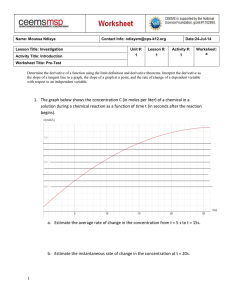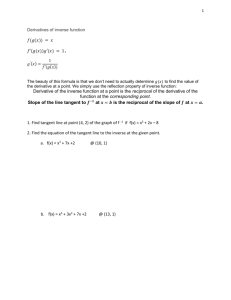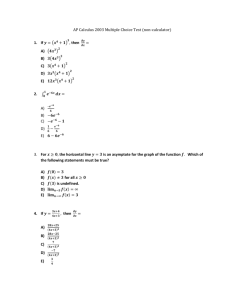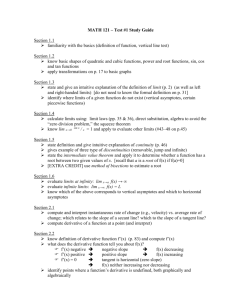f'(x)
advertisement
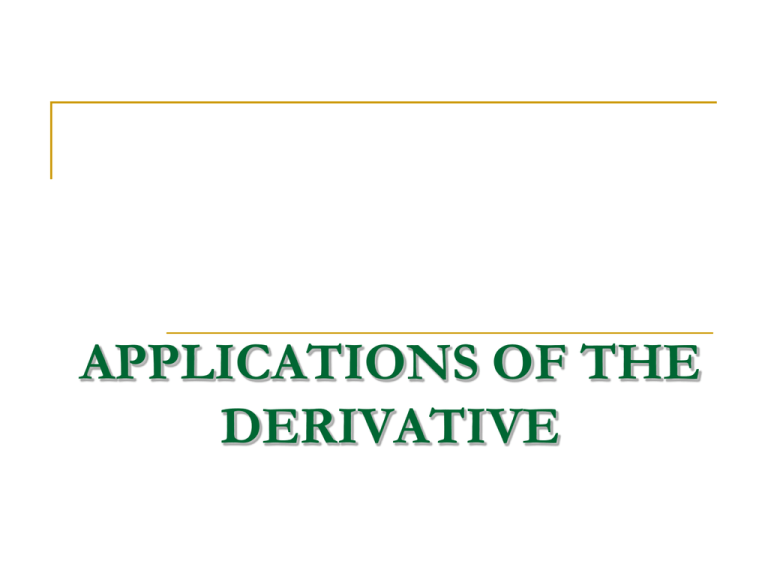
APPLICATIONS OF THE DERIVATIVE SUMMARY OF PREVIOUSLY STUDIED MATERIAL In chapter 1, we had studied limits. An informal and most commonly used definition of the limit is simply the question, “When I make x closer and closer and closer to some number c, what f(x) am I approaching to?” Asymptotes were explored using limits. Limits help determine end-behavior. Continuity was briefly mentioned. Continuity is present at x=c is f(c) exists, if the limit as x approaches c from both sides exist and are the same value, and if the limit as x approaches c and f(c) are equal. SUMMARY With the help of limits, we were able to calculate instantaneous rates, and the slope of the line tangent to the curve at a certain point. By letting the change in x be infinitesimally small in the slope formula (difference quotient), we are able to get derivatives. A differentiable function is continuous function, but a continuous function is not always differentiable. DERIVATIVES. Practice of derivative rules and formulas must be emphasized. Derivatives and Integrals (next chapter) will be the backbone to calculus. Definitely study the differentiation rules from the last chapter!!!!!! APPLICATIONS OF THE DERIVATIVE This chapter will underscore the uses of derivatives in the following cases. How to graph functions by knowledge of critical points and derivatives. How to differentiate inverse, exponential and logarithmic functions. Differentials Related rates and optimization problems CURVE SKETCHING You can easily graph any function by knowing three things. 1) ZEROS AND UNDEFINED SPOTS 2) MAXIMUM AND MINIMUM POINTS 3) CONCAVITY AND INFLECTION POINTS. CRITICAL POINTS Let’s find the points where the function is zero or undefined. We want to graph f(x)=x3+2x2+x. Obviously, there are no undefined spots, due to the fact that this is a polynomial function. All polynomial functions are continuous, thus differentiable. To find the zeros, set the entire function to 0. 0= x3+2x2+x Original function 0=x(x2+2x+1) Factored 0=x 0=(x+1)(x+1) Factored the trinomial and set both factors equal to zero. x=0, -1 x is solved for. Thus x=0 and x=-1 MAXIMUM OR MINIMUM POINTS Here is the graph of the f(x). MAXIMUM AND MINIMUM Notice that if you draw tangent lines at the maximum and the minimum, you will see that you will get horizontal lines. That means the slope is zero. Thus, the derivative is zero. In other words, at a maximum or minimum, the derivative is zero. MAXIMUM AND MINIMUM POINTS Since the f’(x)=0, we can solve for the maximum and minimum points. First, find the derivative of f(x)=x3+2x2+x. f’(x)= 3x2+4x+1 Differentiation using power rule and sum/difference rule. 0 = 3x2+4x+1 Max/Min always have f’(x)=0. 0=(3x+1)(x+1)Factoring to solve for x. 0=3x+1 0=x+1 Setting factors equal to 0. x=-1/3 and x=-1 Solve for two answers of x. We know that x= -1/3 and x=-1 are the possible points, however, without a graph, we cannot determine which is the max and which one is the min. SIGN ANALYSIS TEST FOR MAX/MIN. You can do a sign chart and determine the sign between possible zeros. Look how it is set up. What the sign of the two factors to the right of x=-1/3? What is the sign of the two factors between -1 and -1/3? What is the sign of the two factors to the left of -1? Since they are factors, you multiply them. Account for overall sign. DERIVATIVE OF SIGNS If the derivative goes from negative slope to zero to positive slope, then x is where the minimum is. If the derivative goes from positive slope to zero to minimum slope, then x is where the maximum is. zero zero WHAT WE KNOW We know that this is a cubic function, with x=1 and x=0 as the two zeros. No undefined points We know that the maximum is at x = -1 and the minimum is at x= -1/3. HORIZONTAL TANGENTS Be careful when solving for x when f’(x) is 0. Perhaps you will have such function where the slope is zero at a certain point, but that point is neither maximum nor minimum. y(x)=x3 for example. Once you differentiate that, you get y’(x)=3x2. y’(x)=0. Therefore, you equate 0 and 3x2. You will see that x = 0. However, by doing a sign analysis chart, you will see that before and after 0, there is no sign change. The slope continues to be positive. CONCAVITY Concavity is very difficult to define. A good way to define concavity is using a spoon. When you hold a spoon the right way (where the milk is in the spoon), the spoon is said to be concave up. When the spoon is down (when the milk is not in the spoon… the spoon is not in the right way), then the spoon is said to be concave down. CONCAVITY An upward parabola is concave up. A downward parabola is concave down. The f(x) is above the tangent line when it is concave up. The f(x) graph is under the tangent line when it is concave down. The concavity is the rate of slope change. Hint hint!! RATE OF CHANGE!! The rate of change of the slope, means the derivative of the slope… The slope is the derivative of the function. So the concavity is the derivative of the derivative. The first derivative of slope and the second derivative of the function. CONCAVITY GRAPHS Both function have positive slopes. f’(x)>0. However, the red function is concave up, since it is above the tangent line. The blue function is concave down, RED since it is f’(x)>0 below its tangent lines. f’’(x)>0 BLUE f’(x)>0 f’’(x)<0 Both function have negative slopes. f’(x)<0. The blue function is concave up, since it is above the tangent line. The red function is concave down, since it is below its respective tangent line. RED f’(x)>0 f’’(x)<0 BLUE f’(x)>0 f’’(x)>0 ZERO CONCAVITY Remember when the function, f(x), was at a maximum or minimum, the derivative, the slope, f’(x) was 0. When the slope is at its maximum or minimum, the derivative of the slope is 0. In order words, when f’(x) is at its maximum or minimum, then the derivative, f’’(x), the concavity will be 0. Concavity is the slope of the slope. !! Side note: Vertical tangents. Let’s examine for a moment, the vertical line graph. There is no such function that when graphed has a vertical line. If you look at the slope of a line (Dy/Dx). You will see that the difference in y is some number. However, since there is no change in x, that will be equal to zero. n/0 is infinitely big that is undefined. However, there are functions with vertical tangents. The cube root of x at x=0 has a vertical tangent. Therefore, the derivative of the cube root function will be defined everywhere except x=0. Just be aware of that! CONCAVITY AND INFLECTION POINTS The point where the change in derivative sign (positive vs. negative slope) is called extrema (i.e. max/min points) f(max) and f(min), their derivatives at those points will both be 0. The point where the change in concavity occurs is called the inflection point. Since this is where the slope, f’(x), is the maximum, the steepest or the flattest, the derivative of slope, f’(x), will be 0. After solving for x and doing a sign analysis, you will find the inflection points. FINDING INFLECTION POINTS The original function was x3+2x2+x. Since we want to find the inflection point, we must obtain the second derivative. f(x)= x3+2x2+x. GIVEN f’(x)= 3x2+4x+1. FIRST DERIVATIVE f’’(x)=6x+4 SECOND DERIVATIVE Since the inflection points are found by solving for x when f’’(x) = 0. 0=6x+4 f’’(x) =0 x= -2/3 SOLVED FOR X. Now we must do sign analysis. Everything right of -2/3 for the factor 6x+4 is positive. Everything left of it is negative. Thus, x=-2/3 is an inflection point for x3+2x2+x. Everything right of x=-2/3 is concave up. Everything the to left of x=2/3 is concave down. When sketching this curve… Make sure your zeros are at the x values. Make sure your max, mis, and horizontal tangents are drawn at the proper spots. Make sure your inflection point is accurately drawn. A good way of thinking about inflection points is when the tangent lines switch sides with respect to the graph. YOUR GRAPH f’(x)>0 f’’(x)>0 f(x)=0 f’(x)=0 f’’(x)<0 ZERO MAXIMUM ZERO f’(x)<0 f’’(x)>0 f’(x)<0 f’’(x)<0 f’(x)>0 f’’(x)<0 INFLECTION POINT f’(x)<0 f’’(x)=0 f(x)=0 f’(x)=0 f’’(x)>0 MINIMUM ROLLE’S THEOREM Some people hate calculus a lot. For example, they might like to find instantaneous velocity by saying distance/time. But we know that is not true. Rolle was a mathematician who tried to disprove calculus. He disliked it very much. He wanted to a lot of geometry and algebra. Well, you know, if you hate something a lot, it is just as much as loving it a lot. Similarly, Rolle hates calculus so much, that he had a theorem that is very helpful IN calculus. This theorem will not be tested very frequently in exams, but its best to know it anyway. ROLLE’S THEOREM (MEAN VALUE THEOREM) There will always be an average rate line that will be parallel to the tangent line of a certain point. This means they have the same slope. You can see that the average rate line between x=-2 and x=2 is parallel to the tangent line of x=0. Thus, you can conclude, that they have the same slope. f (b) f (a) f ' (c ) ba DIFFERENTIATION OF INVERSE FUNCTIONS An inverse of a function is found by reflecting the graph over the line y=x. The function is found simply by switching the y with the x and vice verse.. For example: If y = 3x+2 with coordinates (0,2) as one possible point, then its inverse is x=3y+2 with coordinates (2,0). I just switched the x and y around. That’s all. Sometimes, a function may have an inverse that is not a function. y=x2 is function and x=y2 is not. Remember, a function is a function if for any x, there is one and only one y value. The vertical line test determines that. (Course III Info for N.Y.S students). DIFFERENTIATION OF INVERSE FUNCTIONS From pre-calculus, you know that if f(x) has its inverse g(x), then the composition f(g(x)) is x. If f(x) has g(x) as its inverse function, then the formula for finding the derivative of a function is…. dy 1 dx f ' ( g ( x)) DERIVATIVE OF THE INVERSE OF y=x2. f(x) g(x) Composition of f and g dy/dx of f(x) Composition of f’ and g. f ( x) x 2 g ( x) x f ( g ( x)) f ' ( x) 2 x x 2 f ' ( g ( x)) 2 x Inv. Deriv. Formula Substitution. dy 1 dx f ' ( g ( x)) dy 1 dx 2 x CHECK You can check it also using the power rule. y xx dy 1 x dx 2 1 2 1 2 1 2 x DERIVATIVE OF EXPONENTIAL FUNCTIONS The natural exponential function, f(x)=ex, has the base e. e is a transcendental number (just like 16,108, p, f...). It is named after its founder, Leonard Euler. e is derived and found many ways. e is a very special number in calculus. You will see why in a moment. e is approximately 2.718… If you define it using limits, e = … 1 e lim 1 x x x DERIVATIVE OF THE EXPONENTIAL FUNCTION Derivative definition f(x)=ex Law of exponents, ex+h=(ex)(eh) Factor out ex. Previously proven limit Product Rule of limits Derivative f x h f x lim h 0 h e xh e x lim h 0 h e xeh e x lim h 0 h e x (e h 1) lim h 0 h eh 1 lim 1 h 0 h e x (1) ex THE DERIVATIVE OF THE EXPONENTIAL FUNCTION This is one of the two functions whose derivative is its own function! d(ex)=ex! Amazing how transcendental functions work! Jaya! Jaya! d x x e e dx THE NATURAL LOGARITHM FUNCTION y=ln x The natural logarithm is NOT taking a piece of log naturally from a tree, play rhythms on it! The natural logarithm is the inverse of the natural exponential function. It has e as its base. There are many ways y=ln x is derived by. y=ln x is defined for all x>0. We can find the derivative using the inverse differentiation rule since ln x is the inverse of ex. DIFFERENTIATING y=ln x. f(x) g(x) inverse of f(x) Composition of f(x) and g(x) dy/dx of f(x) Composition of f’(x) and g(x) If f’(g(x)) = f(g(x)), and if f(g(x)) = x, then f’(g(x))=x. Inverse Differentiation Rule Replacing f’(g(x)) with x. f ( x) e g ( x) ln x x f ( g ( x)) e ln x f ' ( x) e x f ' ( g ( x)) e x dy 1 dx f ' ( g ( x)) dy 1 dx x ln x THEREFORE… I find it pretty cool that an algebraic function like y = 1/x is the derivative of transcendental function y = ln x. Transcendental functions are functions that cannot be derived simply by algebra. d 1 ln x dx x INVERSE TRIGONOMETRIC FUNCTIONS The inverse of the function y = sin x is y= arcsin x. NOTE: arcsin x is NOT a function. For example, arcsin (½) = p/3, 5p/6, -7p/6, -11p/6, so on… since one x value produced an infinite number of y values, you know that this is not a function However, Arcsin x IS a function (notice capital A, compared to previous lower-case a). Arcsin x is restricted from [-p/2, p/2], just as Arccos x is restricted from [0,p] and Arctan x is restricted from (-p/2, p/2). Note that the () parenthesis represent the open interval excluding endpoints. Remember than tan (p/2) = ∞. If you look at the inverse cosine function, you will notice that it is just the inverse sine function reflected over the x axis. Therefore, the slope, the derivative, of the inverse cosine function will be negative the slope, derivative, of the inverse sine function. Same thing will occur with tangent and cotangent, secant and cosecant functions. d(arcsin x)=-d(arccos x) d(arctan x)=-d(arccot x) d(arcsec x)=-d(arccsc x) DIFFERENTIATION OF THE ARCSINE FUNCTION f(x) g(x) inverse function Composition of f and g. dy/dx of f Composition of f’ and g. Derivative formula for finding inverses of functions Applying f’(g(x)). What is cos(arcsin x)? f ( x) sin x g ( x) arcsin x f ( g ( x)) sin(arcsin x) f ' ( x) cos x f ' ( g ( x)) cos(arcsin x) dy 1 dx f ' ( g ( x)) dy 1 dx cos(arcsin x) The denominator To simplify the denominator to more practical terms, we know that y=arcsin x is the same as sin(arcsin x)= sin y = x. Then to solve for cos y. Pythagorean Trig Identity sin y cos y 1 sin y = x x cos y 1 Solved for cos y. cos y 1 x 2 2 2 2 2 AFTER APPLYING cos y IN THE DENOMINATOR… We see that… d arcsin x 1 2 dx 1 x d arccos x 1 2 dx 1 x USING THE SAME PROCESS… If you use the derivative of an inverse rule for the arctangent and the arcsecant functions, you will see that d 1 arctan x 2 dx 1 x d 1 arc cot x 2 dx 1 x d arc sec x dx x d arc csc x dx x 1 x2 1 1 x 1 2 MISCELLANEOUS THINGS TO KNOW Some textbooks will make great emphasis on this. Other textbooks won’t talk about it too much. Since the AP and many college calculus I courses do not test this topic greatly, I won’t discuss it in great depth. You can treat dy/dx as a fraction of the infinitesimally small change in y over the infinitesimally small change in x. You can consider y = x2, dy = 2x dx since dy/dx = 2x. dy is said, “a differential amount of y.” Differential means an infinitesimal change in a specific direction. EXAMPLE DIFFERENTIAL PROBLEM If you take a cube with each side having length 8, what is the differential volume if you have a cube that has each side having length 7.99? PROBLEM WORKED OUT The volume of a cube is given dV/dx is the differential amount of volume over the differential amount of change in length. The change in length is simply 8-7.99=.01=dx. Multiply both sides by it so you isolate dV. Then plug in 7.99 for x, and plug in 0.01 for dx and calculate the differential amount of volume. V x 3 dV 3 x dx 2 dV 3(7.99) (.01) dV 1.92 2 APPLICATION At the Sri Sri Gaura Nitai temple, they want to make the rectangular temple room such that the perimeter is 1000 feet. Find the maximum length and width so that everyone can have the fortune to the Sri Sri Gaura Nitai. In addition, find the area. OPTIMIZATION Optima- what??? Optimization problems is a fancy way of saying maximum minimum problems. The best way to start out is to draw a picture to help yourself visualize the problem. THEN.. Since we have two variables, ℓ and w, we have to solve everything in terms of one variable. We know that A= ℓ w and Prect = 2 ℓ +2w. So we can solve for ℓ in either equation. Most preferably use the P equation. Prect 2 w 2 And finally… Substite the expression for l into the area formula. Prect 2w 2 A w Prect 2w A w 2 1 A Prect w w2 2 According to the problem… P = 1000 ft so… A 500w w But to find maximum w, the derivative will have to equal 0. Then solve for w. 2 A 500 w w 2 dA 500 2 w 0 dw 500 2 w 250 ft w Then… Plug w in for the expression for length. Coincidentially, the width and length are the same. Therefore, the temple room will be square so that everyone could see the Lord Sri Sri Gaura Nitai Jaya! 1000 2 w 2 500 w 500 250 250 ft FIND THE AREA… Simple.. The length is 250 ft. The width is 250 ft. Multiply them together.. A= 625,000 sq ft. Nice big temple ain’t it?? HARI HARI BOL!!!! RELATED RATES Remember how I constantly emphasized, RATE = DERIVATIVE Rate specifically deals with time. Here is an example: The diameter and height of a paper cup in the shape of a cone are both 4 in. and water is leaking out at the rate of 0.5 in3/ sec. Find the rate at which the water level is dropping when the diameter of the surface is 2 in. VARIABLES SOUND NICE.. (laughs) V is volume in cubic inches h is height. t is time Volume formula (known) 2r = h, since diameter=h. 1 2 V πr h 3 2 1 h V π h 3 2 πh V 12 3 Differentiate with respect to time Remember now… we are differentiating with time!!! So, we must differentiate implicitly!! Remember chapter two?? Since we know that the rate of leak is ½ cu in/ sec, dV/dt is – ½ since we are decreasing. Solve for the rate of change for the height. Since there is no variable for time, the rate of change for the height is constant for any value of t. Replace the h with 2 in and the rate of the water level is dropping with the height and time is 1/2p in/sec. πh 3 V 12 dV 3πh 2 dh πh 2 dh dt 12 dt 4 dt dV 1 dt 2 dh 1 4 2 dt 2 πh dh 1 4 1 2 dt 2 π2 2π SUMMARY We covered a good amount of material in this chapter. Let’s go over what we learned. You can find the maximum or minimum of f(x) by setting f’(x) = 0. Solve for x and do a sign analysis. You can find concavity of f(x) by setting f’’(x)=0. Solve for x and do a sign analysis. DERIVATIVES We learned how to differentiate more functions using the inverse rule. COMMIT THESE TO MEMORY AS WELL AS THE FUNCTIONS IN CHAPTER TWO!!! IF YOU DO NOT REMEMBER ANY FUNCTION’S DERIVATIVE, DO NOT GO ON TO CHAPTER FOUR!! COMMIT EVERYTHING TO MEMORY!!!! d x e ex dx d ln x 1 dx x d arcsin x 1 dx 1 x2 d arccos x 1 dx 1 x2 d arctan x 1 2 dx 1 x d arc sec x 12 dx x x 1 d 1 arc csc x dx x x2 1 d arc cot x 1 2 dx 1 x OPTIMIZATION/RELATED RATES For optimization problems, relate everything to one variable. For example, area and perimeter with sides a and b. Solve for a, for example, and plug the a expression in for the area formula so you have an area function A(b). Then differentiate that and set it equal to 0. DON’T FORGET SIGN ANALYSIS!!! For related rate problems, gather all of your variables together and use any geometry formulas you need. Differentiate with respect to TIME. You most likely will need to use implicit differentiation. It It helps in both scenarios to draw a picture of the problem to get a better understanding. TEST Please visit the following website to take a practice exam and please look over the answers. If you have any difficulty, please e-mail me at kksongs_1@hotmail.com. Please read help statement prior to e-mailing me. Good luck! Hare Krsna!
